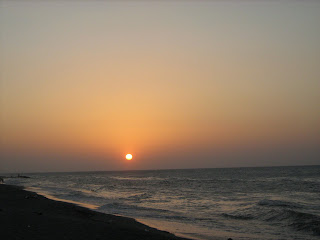At the end of March, I realized that there was this horrendously loud noise coming from the street behind my apartment. It seemed to consist of an air compressor and some sort of metal cutting blade and would go on and off for hours at a time.
My first thought was “Oh no, someone’s started an auto body shop in their yard!” which has been known to happen as there are industrial shops right next door to family homes in most barrios.
After a couple days, it appeared that the noise had moved off somewhat and that’s when my curiosity kicked in. So off I went, following my ears and discovered some pretty big changes just around the corner!


Great mounds of dirt and debris right in the middle of the intersections, huge, gaping holes in the pavement and a series of lines cut into the pavement of the streets of the whole neighbourhood. I found it quite amusing to be able to simply climb right up on the piles to take photos without being questioned or stopped by anyone. No barricades to protect pedestrians from themselves, taxis and private cars slowly creeping around various mounds in order to traverse the streets and not a worker in sight.
The work is progressing, slowly but surely and has now reached the point where some of the underground infrastructure is being established. I’ve learned that this whole endeavour is to provide “black water” (sewage) lines from individual homes, to a central pipe and thus (hopefully, though I’m not certain!) to a treatment plant.


There aren’t a lot of technical or specialized tools used. If you look closely, you can see the nylon line tied to the rock and stick that is used for establishing the cutting lines. I’m left wondering whether or not there will be powered jack hammers or simply labourers with pick axes used when it comes time to lift the segments of asphalt.
I do find it quite disturbing to watch both the operator and helper of the machine that is used to cut the pavement lines. Yes, they have hard hats, a short sleeved over shirt and work boots but I have yet to see hearing protection, work gloves or any form of air mask! The residents are curious about the work but at the same time terribly accepting of the overwhelming noise levels, with an attitude of “it has to happen”.


I’m leaving the country in a couple of days so sadly won’t be able to keep a complete record of this major project though I am hoping that it will be completed before I come back again next winter!
Anyone interested in taking their life in their hands and getting a job in La Ceiba?































 There is also a municipality organized schedule of garbage pickup in the various areas of La Ceiba. I have learned that my barrio, Colonia La Alhambra has their pickup day on the Tuesday of the week and have watched the process.
There is also a municipality organized schedule of garbage pickup in the various areas of La Ceiba. I have learned that my barrio, Colonia La Alhambra has their pickup day on the Tuesday of the week and have watched the process.












